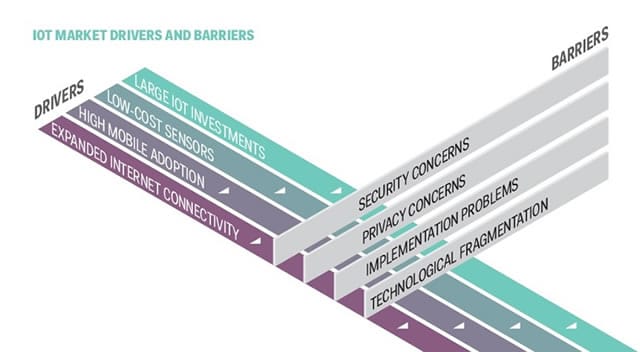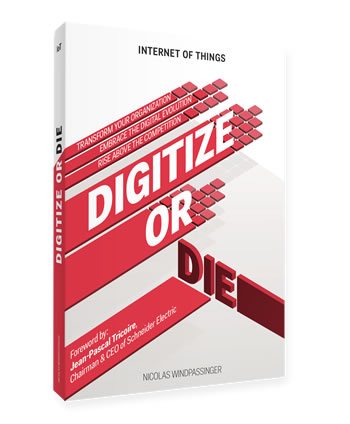A look at essential IoT market drivers and IoT market barriers which need to be addressed for successfull IoT projects.
We previously covered an interesting new Internet of Things book on the market, written by a seasoned Internet of Things expert, Nicolas Windpassinger. His IoT book Digitize or Die offers a no-nonsense overview of the IoT in a context of digital transformation.
In our interview with the author of the IoT book, entitled Digitize or die (the good old mantra of several industries that has reached many more as IoT affects most), he explains why the Internet of Things is at its inflection point and why companies need to enter the window of opportunity. In his IoT book, Nicolas Windpassinger, who is VP of Schneider Electric’s awarded EcoXpert Partner Program offers a strategic framework to do so.
Via the website of ‘Digitize or Die’, you can obtain the IoT infographics which have been made for the book. In one of them, Windpassinger shares four IoT market drivers and four IoT barriers. You can see them below. Some comments and additions.

IoT market drivers: the brewing of a perfect industrial transformation storm
In the drivers of the IoT market we respectively see the expansion of Internet connectivity, the high adoption of mobile (and let’s add the emergence of new mobile technologies in IoT such as LPWAN that offer more choice, options and decreased costs, depending on the IoT use case, and of mobility as such), the declining cost of sensors as it’s been going on since several years and the growth of large IoT investments.
It’s true that with the dominance of IP networks and ubiquitous connectivity the conditions for a faster growth of IoT applications were shaped. They indeed did so along with low-cost sensors, actuators, transducer systems and declining hardware costs overall, the omni-presence of mobile and the fact that mainly organizations started investing in IoT ahead of many that are still lagging behind.
Not that it’s always needed to be a first mover but it is a well-known fact that IoT investments are highest (among others given the scope and types of IoT deployments and sought benefits) in predominantly industrial markets. This goes hand in hand with the ‘birth’ and expansion of the Industry 4.0 vision and similar approaches such as the Industrial Internet and Logistics 4.0.
The latter is not about to change any time soon although analysts foresee a growing importance of the consumer IoT and of the home automation or smart home market.
However, industries such as manufacturing (where Industry 4.0 was born) and logistics, to name a few remain leaders from an IoT investment perspective until certainly 2020.
A fifth IoT market driver we add is the growing importance of automation, big data analytics, the role of actionable knowledge and thus data as a key business asset and the various technologies which enable the Internet of Things to achieve information-based outcomes and innovations or find fertile ground for innovation when used together with IoT.
This is where the majority of the current IoT use cases is as well, albeit with a major focus on areas such as automation, optimization, monitoring and maintenance and still less on the innovation and Internet of Services part. You have probably heard about IDC’s third platform technologies and the innovation accelerators on top of them: they all meet in IoT and the integration of IT and OT, depending on the use case and virtually always with information as the glue and insights as the goals to an end.
Four IoT market barriers: to succeed, face the challenges
Let’s not beat around the bush and say it loud and over and over again: many IoT technologies, applications and devices out there are real security nightmares.
So it isn’t a surprise that security concerns are IoT market barriers. And they should be. In this day and age security cannot be an afterthought and needs to be a holistic end-to-end given. Let there be no doubt.
In IoT there are many security challenges that are less known by IT and by OT people. There are different technologies whereby security by design must take center stage in an integrated way. And even then it’s not just a matter of applying some security frameworks but also about asking sound questions about IoT security on the short and long term, and about relying on vendors, partners and experts who follow what the ‘bad guys’ do closely as they are working in increasingly sophisticated ways. Never avoid the IoT security question.
The same goes for the second IoT barrier, privacy concerns. Here as well a ‘by design’ approach is needed. And in this day and age security, data management and privacy are intrinsically connected.

The final two IoT market barriers Windpassinger mentions in the infographic and expands upon in his book are implementation problems and technological fragmentation. Think skillsets, standards and interoperability, the disconnect that de facto exists between IT and OT, the different worlds that are meeting in real-life IoT projects (with their own skills) and far more.
One might be tempted to think that many of these IoT market barriers (e.g. security and implementation problems) mainly exist in consumer IoT environments and applications. Yet, this is certainly not the case. We previously tackled the concerns of decision makers with regards to security and the Industrial Internet of Things. They are real concerns in the Industrial IoT too so address them.
A successful IoT deployment takes into account the barriers as much as the drivers and benefits. That’s why an IoT strategy is essential as is any crucial and impactful business and even society phenomenon. You need to have a strategy and look at the full picture.
That’s one of the things Windpassinger does in his IoT book, ‘Digitize or Die’.

